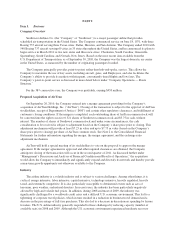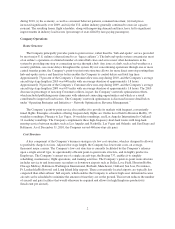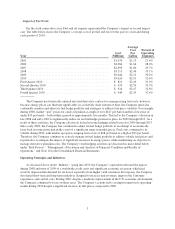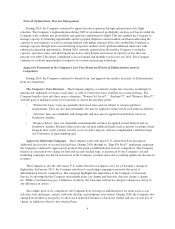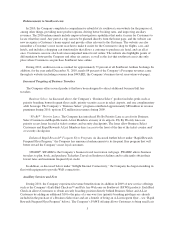Southwest Airlines 2010 Annual Report Download - page 17
Download and view the complete annual report
Please find page 17 of the 2010 Southwest Airlines annual report below. You can navigate through the pages in the report by either clicking on the pages listed below, or by using the keyword search tool below to find specific information within the annual report.Wright Amendment State. The Wright Amendment did not restrict flights operated with aircraft having 56 or
fewer passenger seats, nor did it restrict the Company’s intrastate Texas flights or its air service to or from
points other than Dallas Love Field. In 2006, the Company entered into an agreement with the City of Dallas,
the City of Fort Worth, American Airlines, Inc., and the DFW International Airport Board, pursuant to which
the five parties sought enactment of legislation to amend the Wright Amendment. Congress responded by
passing the Wright Amendment Reform Act of 2006, which immediately repealed the original through service
and ticketing restrictions by allowing the purchase of a single ticket between Dallas Love Field and any
U.S. destination (while still requiring the Customer to make a stop in a Wright Amendment State), and reduced
the maximum number of gates available for commercial air service at Dallas Love Field from 32 to 20. The
Company currently has access to 16 gates at Dallas Love Field. Pursuant to the Wright Amendment Reform
Act and local agreements with the City of Dallas with respect to gates, the Company can expand scheduled
service from Dallas Love Field and currently intends to do so. The Wright Amendment Reform Act also
provides for substantial repeal of the remainder of the Wright Amendment in 2014.
Operational, Safety and Health Regulation
The Company and its third-party maintenance providers are subject to the jurisdiction of the FAA with
respect to the Company’s aircraft maintenance and operations, including equipment, ground facilities, dispatch,
communications, flight training personnel, and other matters affecting air safety. To ensure compliance with its
regulations, the FAA requires airlines to obtain, and the Company has obtained, operating, airworthiness, and
other certificates. These certificates are subject to suspension or revocation for cause. In addition, pursuant to
FAA regulations, the Company has established, and the FAA has approved, the Company’s operations
specifications and a maintenance program for the Company’s aircraft, ranging from frequent routine inspections
to major overhauls. The FAA, acting through its own powers or through the appropriate U.S. Attorney, also has
the power to bring proceedings for the imposition and collection of fines for violation of the Federal Aviation
Regulations.
In September 2010, the FAA issued a Notice of Proposed Rulemaking (“NPRM”) proposing certain changes
to flight and duty time limitations and rest requirements for pilots. The FAA’s proposed amendments would
(i) increase to nine hours the minimum opportunity for rest prior to the duty period; (ii) establish a new method
for measuring a pilot’s rest period, so that the pilot would be assured the opportunity to receive at least eight
hours of sleep during that rest period; (iii) place weekly and 28-day limits on the amount of time a pilot may be
assigned any type of duty; and (iv) require pilots to be given at least 30 consecutive hours free from duty on a
weekly basis, a 25 percent increase over the current rules. Moreover, in January 2010, the DOT issued an NPRM
with regards to lithium batteries carried on commercial aircraft. If adopted, the DOT proposal could significantly
impact the Company’s cargo operations.
The Company is subject to various other federal, state, and local laws and regulations relating to
occupational safety and health, including Occupational Safety and Health Administration and Food and Drug
Administration regulations.
Security Regulation
Pursuant to the Aviation and Transportation Security Act (“ATSA”), the Transportation Security
Administration (the “TSA”), a division of the U.S. Department of Homeland Security, is responsible for certain
civil aviation security matters. ATSA and subsequent TSA regulations and procedures implementing ATSA
address, among other things, (i) flight deck security; (ii) the use of federal air marshals onboard flights;
(iii) airport perimeter access security; (iv) airline crew security training; (v) security screening of passengers,
baggage, cargo, mail, employees, and vendors; (vi) training and qualifications of security screening personnel,
(vii) provision of passenger data to U.S. Customs and Border Protection; and (viii) background checks. Under
ATSA, substantially all security screeners at airports are federal employees, and significant other elements of
airline and airport security are overseen and performed by federal employees, including federal security
managers, federal law enforcement officers, and federal air marshals. TSA-mandated security procedures can
affect the Company’s operations, costs, and Customer experience. For example, in 2006, the TSA implemented
11


